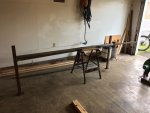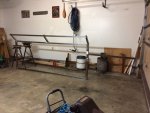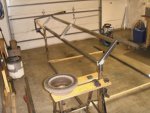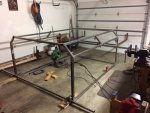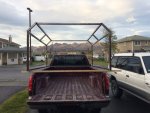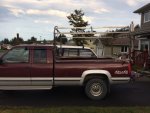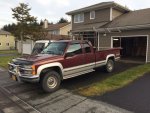mr_ed
Toolbag
So after much lurking I've decided to go ahead and start a thread to document my upcoming spring project.
The truck, while not what I would consider my "Ultimate Dream Truck," is one that my wife and I decided on since we needed a pickup of some sort. My family owned a 90's Chevy (TBI 350) when I was a kid with great success, and I was looking for a good dependable truck to handle hauling our ATV and anything else I may need, towing a decent-sized trailer every 4 years when we transfer (I'm in the Coast Guard), and still be easy for my wife (who is not a motor head) to drive daily if necessary.
We ended up getting a 1997 Chevy Silverado 2500, 4x4, with a 454 and only 91k miles, that also happened to have already had the problematic stock injectors replaced with Bosch injectors, the whole intake manifold re-sealed, new plugs, wires, tie rods, ball joints, wheel bearings, and brakes redone in the last 2-5k miles (with receipts). New tires too, although that males it harder for me to justify slightly bigger A/Ts haha.
As much as I would love a 1st or 2nd gen 12 valve, this truck is meeting our needs perfectly here on Kodiak, and returning high 13s-low 14s at the pump, which is better than I was expecting from a 454. Considering most of our daily driving is only a handful of miles (and there's only about 40 miles of road on the island), it suits us better than a diesel...especially considering we wouldn't be capitalizing on a diesel's benefits enough to offset the high maintenance cost and initial purchase cost.
Here's a pic from the Homer spit after we bought it a couple months ago, waiting on the ferry for Kodiak:

As of right meow, I plan on leaving the truck itself mostly stock. I may consider leveling kit/rear add-a-leaves for 1-2" of lift (or 1-2" body lift) and larger tires (33" max) down the road, but for now I enjoy the dependability and gas mileage as it is. Plus, if I really need to get somewhere, I have a 1998 Montero with a winter package that really doesn't take no for an answer.
The main focus of this thread will be on building my own camper shell. I had a couple of requirements that were tough to meet with off-the-shelf shells. It needed to be tall enough that I could sit up comfortably while camping in it (I'm 6' and awkward, so I don't dig cramped spaces), have an easily folded sleeping platform so I can drive the quad into the back, be relatively lightweight, simple and rugged enough to handle everyday utilitarian use, but also be insulated for some level of comfort during cold weather camping trips, and still look good (to my eye anyway) to name a few.
Most commercially available shells that would come close are rather spendy, meet maybe half the requirements, and/or look like something the power company uses or are lost in the '60s styling-wise.
I have most of the material to begin building, minus a few odds and ends. The primary structure will be a frame made from 1.5" steel tube that will essentially look somewhat like a ladder rack, then 2x2 lumber will make up the rest of the "studs." Plywood for the skin, probably sheathed in fiberglass, as that will not only completely waterproof if, but will allow for a thinner (lighter) ply skin. Foam panel insulation, with a veneer ply on the inside. The steel primary frame will also allow me to through-bolt some heavy duty roof rack crossbars and be able to carry a good amount of weight up there if necessary (kayaks etc...)
A cabover portion, while not big enough to sleep in, will allow storage of camping gear, sleeping bags, and whatever else to keep it out of the bed when hauling a quad or other large load. Ultimately, the goal is to have a well built shell that finds a compromise between the pure utility canopies and full-on slide-in campers. More camping comfort than a cab-high canopy, but more everyday useability than a camper.
Here are a few Sketchup screenshots I worked up the other day for visualization purposes. The lights and jerry can were stuck on just for poops and giggles, but the dimensions are pretty much exact (the shell is drawn to measurements I pulled off our truck; however the pickup model I found for use in the program is slightly out of proportion, so the cab top runs into the cabover section, and the bed is about 2" longer than real life)



Hopefully work will slow down soon and I can start cutting and welding. I still need to do some brainstorming as to what gauge steel tube to use to get decent strength without packing on the pounds. I don't need actual contractor ladder/lumber rack levels of strength; just enough to tote a kayak or two, maybe a cargo box or a couple jerry cans, and be able to climb up there without breaking it. I'm thinking 1.5 square, 16 ga. If anybody has some insight, please let me know!
Cheers!
Ed
Sent from my iPhone using Tapatalk
The truck, while not what I would consider my "Ultimate Dream Truck," is one that my wife and I decided on since we needed a pickup of some sort. My family owned a 90's Chevy (TBI 350) when I was a kid with great success, and I was looking for a good dependable truck to handle hauling our ATV and anything else I may need, towing a decent-sized trailer every 4 years when we transfer (I'm in the Coast Guard), and still be easy for my wife (who is not a motor head) to drive daily if necessary.
We ended up getting a 1997 Chevy Silverado 2500, 4x4, with a 454 and only 91k miles, that also happened to have already had the problematic stock injectors replaced with Bosch injectors, the whole intake manifold re-sealed, new plugs, wires, tie rods, ball joints, wheel bearings, and brakes redone in the last 2-5k miles (with receipts). New tires too, although that males it harder for me to justify slightly bigger A/Ts haha.
As much as I would love a 1st or 2nd gen 12 valve, this truck is meeting our needs perfectly here on Kodiak, and returning high 13s-low 14s at the pump, which is better than I was expecting from a 454. Considering most of our daily driving is only a handful of miles (and there's only about 40 miles of road on the island), it suits us better than a diesel...especially considering we wouldn't be capitalizing on a diesel's benefits enough to offset the high maintenance cost and initial purchase cost.
Here's a pic from the Homer spit after we bought it a couple months ago, waiting on the ferry for Kodiak:

As of right meow, I plan on leaving the truck itself mostly stock. I may consider leveling kit/rear add-a-leaves for 1-2" of lift (or 1-2" body lift) and larger tires (33" max) down the road, but for now I enjoy the dependability and gas mileage as it is. Plus, if I really need to get somewhere, I have a 1998 Montero with a winter package that really doesn't take no for an answer.
The main focus of this thread will be on building my own camper shell. I had a couple of requirements that were tough to meet with off-the-shelf shells. It needed to be tall enough that I could sit up comfortably while camping in it (I'm 6' and awkward, so I don't dig cramped spaces), have an easily folded sleeping platform so I can drive the quad into the back, be relatively lightweight, simple and rugged enough to handle everyday utilitarian use, but also be insulated for some level of comfort during cold weather camping trips, and still look good (to my eye anyway) to name a few.
Most commercially available shells that would come close are rather spendy, meet maybe half the requirements, and/or look like something the power company uses or are lost in the '60s styling-wise.
I have most of the material to begin building, minus a few odds and ends. The primary structure will be a frame made from 1.5" steel tube that will essentially look somewhat like a ladder rack, then 2x2 lumber will make up the rest of the "studs." Plywood for the skin, probably sheathed in fiberglass, as that will not only completely waterproof if, but will allow for a thinner (lighter) ply skin. Foam panel insulation, with a veneer ply on the inside. The steel primary frame will also allow me to through-bolt some heavy duty roof rack crossbars and be able to carry a good amount of weight up there if necessary (kayaks etc...)
A cabover portion, while not big enough to sleep in, will allow storage of camping gear, sleeping bags, and whatever else to keep it out of the bed when hauling a quad or other large load. Ultimately, the goal is to have a well built shell that finds a compromise between the pure utility canopies and full-on slide-in campers. More camping comfort than a cab-high canopy, but more everyday useability than a camper.
Here are a few Sketchup screenshots I worked up the other day for visualization purposes. The lights and jerry can were stuck on just for poops and giggles, but the dimensions are pretty much exact (the shell is drawn to measurements I pulled off our truck; however the pickup model I found for use in the program is slightly out of proportion, so the cab top runs into the cabover section, and the bed is about 2" longer than real life)



Hopefully work will slow down soon and I can start cutting and welding. I still need to do some brainstorming as to what gauge steel tube to use to get decent strength without packing on the pounds. I don't need actual contractor ladder/lumber rack levels of strength; just enough to tote a kayak or two, maybe a cargo box or a couple jerry cans, and be able to climb up there without breaking it. I'm thinking 1.5 square, 16 ga. If anybody has some insight, please let me know!
Cheers!
Ed
Sent from my iPhone using Tapatalk

